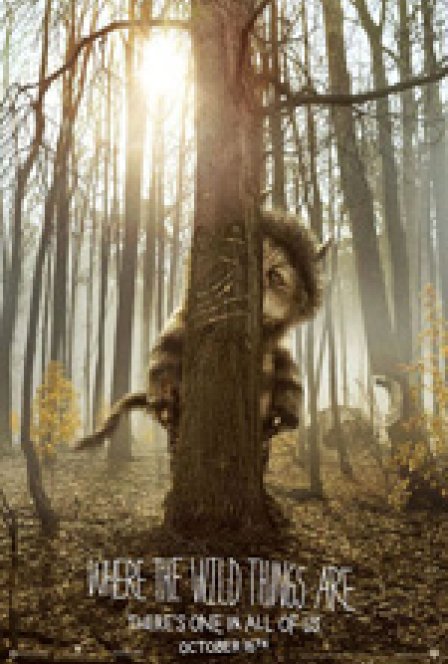It has been a year since the first test footage leaked for Spike Jonze’s much-anticipated adaptation of Where the Wild Things Are, and in that time — and the months since the trailer surfaced — those initial tantalizing glimpses into the universe Jonze had created have been so endlessly watched, discussed, and dissected that it's hard to remember how stunningly fresh those images were when they first appeared. There was a collective sense of “Whoa” for many of us when we caught wind of what Jonze and his team were doing; it looked and felt nothing like what we have come to expect from a purported children’s movie produced by a major Hollywood studio.
Indeed, Where the Wild Things Are is as notable for what it is as what it is not. In another director’s hands, Maurice Sendak’s classic story could have been turned into a flashy, candy-coated piece of CGI fluff. That Jonze was able to envision something so entirely outside the realm of the industry standard for this type of fare — opting instead for a stripped-down, analog approach employing handheld camerawork, natural lighting, and puppets rather than CGI — is a testament to his creative vision. It's easy to see why the studio was worried about this one, with rumors floated about extensive reshoots following an early screening of the film. Too dark and strange to really delight children — Jonze’s Wild Things are far from cuddly — and perhaps too earnest for jaded adults, the film is defiantly anti-commercial both in style and tone. That said, for those who like their fables with a bit of an edge and who are willing to give themselves over to Jonze’s utterly unique worldview, Where the Wild Things Are proves singularly rewarding.
In adapting Maurice Sendak’s book, the challenge that Jonze and screenwriter Dave Eggers faced was expanding the original 10-sentence story into a feature-length film. The basic premise here remains the same: A young boy, Max, dons a wolf costume and his misbehavior causes him to be punished by his mother. Sent into a rage, Max retreats into a fantasy world where he is king of the Wild Things, strange beasts who take pleasure in destruction and disorder, waging a “wild rumpus” long into the night. Max eventually grows weary of this life, however, choosing to return home to his mother. The story endures because it taps into the potential that all of us have to be beastly from time to time and acknowledges the primal pleasure inherent in transgressive behavior — urges that we learn to rein in for the sake of those we love.
The film retains this core message while significantly expanding the relationships between the story’s characters. Jonze and Eggers have fleshed out a backstory for Max (played by Max Records). He is a precocious but lonely kid, whose single mother (Catherine Keener) is unable to give him the attention he needs. One night, while she is preoccupied entertaining a boyfriend, Max flies into a rage, biting her. Thus, Max’s misbehavior in this scene -- which precipitates his voyage to the land of the Wild Things -- is transformed from an act of childish mischief to a vicious, desperate lashing out.
The Wild Things themselves have been given distinct personalities and each develops a complex relationship with Max. Carol (voiced by James Gandolfini), their natural leader, is a mostly affable beast with a dark side that Max comes to fear; Judith (Catherine O'Hara) is a pessimist and paranoiac who turns ferocious when she feels threatened by Max’s presence; KW (Lauren Ambrose), with whom Max strikes up an uneasy friendship, is independent-minded but unnervingly callous. All The Wild Things have a crippling fear of loneliness, are given to intense mood swings, and threaten to fly off the handle at a moment's notice. Their wild rumpuses, at first fun, gradually go beyond mere roughhousing to become savagely violent affairs. Indeed, the extended sequences of these enormous beasts trouncing one another and destroying everything in sight come to take on an increasingly disturbed, nihilistic tone. Max begins to fear for his life as his authority over the beasts wanes and discovers that he craves the love of his mother and the stability of home.
The erratic nature of the Wild Things, coupled with a melancholic undercurrent of existential angst — there is repeated talk about the death of the sun and the end of the world — that runs through the film, gives Where the Wild Things Are an often surprisingly bleak air. Much of the film takes place in a barren, desert-like landscape, and Jonze’s color palette is all understated browns and yellows, with only the occasional glint of the sun to warm the frame. As dark as it is at times, though, Jonze has not lost the humanist core that is at the center of Sendak’s story. What he produces is, ultimately, both undeniably touching and life-affirming.
The few missteps are negligible. Max’s backstory, though believable, feels a bit too familiar, and there is, at times, an over-reliance on Karen O’s acoustic soundtrack to create a sense of dynamism. A scene in which Max is metaphorically rebirthed (emerging from out of KW’s mouth where he at one point hides out from an enraged Carol) just before he realizes he must head back to his mother feels a trifle heavy-handed. However, these are small reservations in a film that is really about a singular look and tone that Jonze nails perfectly. That such a personal work of clear-eyed directorial vision has emerged from a major Hollywood studio is itself cause for celebration.

